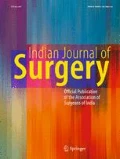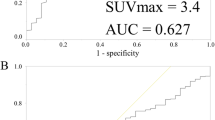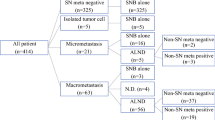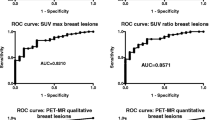Abstract
The aims of this retrospective study were to consider the diagnostic role of dual-time 18F-fluorodeoxyglucose positron emission tomography and computed tomography (18F-FDG PET/CT) in detection of breast carcinoma and axillary lymph node (ALN) status and to evaluate the primary tumor 18F-FDG uptake pattern. Preoperative staging was performed by 18F-FDG PET/CT in 78 female patients with breast carcinoma. Conventional imaging results were evaluated by breast magnetic resonance imaging (MRI) of 79 lesions in 78 patients, bilateral mammography (MMG) of 40 lesions in 40 patients, and breast ultrasonography (USG) of 47 lesions in 46 patients. The primary tumor detection rate using 18F-FDG PET/CT was higher than those using MRI, USG, and MMG. The sensitivity and specificity of 18F-FDG PET/CT scans for detecting multifocality were higher than those of MRI. The specificity of ALN metastasis detection with MRI was higher than that with 18F-FDG PET/CT, but 18F-FDG PET/CT had higher sensitivity. Higher 18F-FDG uptake levels were detected in patients with ALN metastasis, histologic grade 3, estrogen–progesterone-negative receptor status, lymphatic invasion, and moderate to poor prognostic groups. There was no statistical difference for the retention index in categorical pathological parameters except for progesterone-negative status. In conclusion, 18F-FDG PET/CT scans may be a valuable imaging technique for evaluating primary tumor and axillary status in staging breast carcinoma and 18F-FDG uptake may be a prognostic factor that indicates aggressive tumor biology and poor prognosis. Dual-time imaging in breast carcinoma staging may not be used for predicting pathological criteria and the aggressiveness of primary lesions.
Similar content being viewed by others
References
Bevers TB, Anderson BO, Bonaccio E, Buys S, Daly MB, Dempsey PJ, Farrar WB, Fleming I, Garber JE, Harris RE (2009) Breast cancer screening and diagnosis. J Natl Compr Cancer Netw 7:1060–1096
Abdulkareem ST (2014) Breast magnetic resonance imaging indications in current practice. Asian Pac J Cancer Prev 15:569–575
Biglia N, Mariani L, Sgro L, Mininanni P, Moggio G, Sismondi P (2007) Increased incidence of lobular breast cancer in women treated with hormone replacement therapy: implications for diagnosis, surgical and medical treatment. Endocr Relat Cancer 14:549–567. doi:10.1677/ERC-06-0060
Lodge MA, Lucas JD, Marsden PK, Cronin BF, O’Doherty MJ, Smith MA (1999) A PET study of 18FDG uptake in soft tissue masses. Eur J Nucl Med 26:22–30
Yi M, Giordano SH, Meric-Bernstam F, Mittendorf EA, Kuerer HM, Hwang RF, Bedrosian I, Rourke L, Hunt KK (2010) Trends in and outcomes from sentinel lymph node biopsy (SLNB) alone vs. SLNB with axillary lymph node dissection for node-positive breast cancer patients: experience from the SEER database. Ann Surg Oncol 17(Suppl 3):343–351. doi:10.1245/s10434-010-1253-3
Kumar R, Chauhan A, Zhuang H, Chandra P, Schnall M, Alavi A (2006) Clinicopathologic factors associated with false negative FDG-PET in primary breast cancer. Breast Cancer Res Treat 98:267–274. doi:10.1007/s10549-006-9159-2
Hammond ME, Hayes DF, Dowsett M, Allred DC, Hagerty KL, Badve S, Fitzgibbons PL, Francis G, Goldstein NS, Hayes M, Hicks DG, Lester S, Love R, Mangu PB, McShane L, Miller K, Osborne CK, Paik S, Perlmutter J, Rhodes A et al (2010) American Society of Clinical Oncology/College of American Pathologists guideline recommendations for immunohistochemical testing of estrogen and progesterone receptors in breast cancer. J Clin Oncol 28:2784–2795. doi:10.1200/JCO.2009.25.6529
Singletary SE, Connolly JL (2006) Breast cancer staging: working with the sixth edition of the AJCC Cancer Staging Manual. CA Cancer J Clin 56:37–47
Choi YJ, Shin YD, Kang YH, Lee MS, Lee MK, Cho BS, Kang YJ, Park JS (2012) The effects of preoperative (18)F-FDG PET/CT in breast cancer patients in comparison to the conventional imaging study. J Breast Cancer 15:441–448. doi:10.4048/jbc.2012.15.4.441
Garami Z, Hascsi Z, Varga J, Dinya T, Tanyi M, Garai I, Damjanovich L, Galuska L (2012) The value of 18-FDG PET/CT in early-stage breast cancer compared to traditional diagnostic modalities with an emphasis on changes in disease stage designation and treatment plan. Eur J Surg Oncol 38:31–37. doi:10.1016/j.ejso.2011.09.002
Dong G, Wang D, Liang X, Gao H, Wang L, Yu X, Liu J (2014) Factors related to survival rates for breast cancer patients. Int J Clin Exp Med 7:3719–3724
Hwang SO, Lee SW, Kim HJ, Kim WW, Park HY, Jung JH (2013) The comparative study of ultrasonography, contrast-enhanced MRI, and (18)F-FDG PET/CT for detecting axillary lymph node metastasis in T1 breast cancer. J Breast Cancer 16:315–321. doi:10.4048/jbc.2013.16.3.315
Heusner TA, Kuemmel S, Hahn S, Koeninger A, Otterbach F, Hamami ME, Kimmig KR, Forsting M, Bockisch A, Antoch G, Stahl A (2009) Diagnostic value of full-dose FDG PET/CT for axillary lymph node staging in breast cancer patients. Eur J Nucl Med Mol Imaging 36:1543–1550. doi:10.1007/s00259-009-1145-6
Reddy CV, Srivastava A (2009) Role of FDG PET-CT in evaluation of axillary lymph node involvement in T1T2N0 breast cancer in comparison with sentinel lymph node biopsy. J Nucl Med 50(Supplement 2):1691–1691
Inoue T, Yutani K, Taguchi T, Tamaki Y, Shiba E, Noguchi S (2004) Preoperative evaluation of prognosis in breast cancer patients by [(18)F]2-deoxy-2-fluoro-D-glucose-positron emission tomography. J Cancer Res Clin Oncol 130:273–278. doi:10.1007/s00432-003-0536-5
Ekmekcioglu O, Aliyev A, Yilmaz S, Arslan E, Kaya R, Kocael P, Erkan ME, Halac M, Sonmezoglu K (2013) Correlation of 18F-fluorodeoxyglucose uptake with histopathological prognostic factors in breast carcinoma. Nucl Med Commun 34:1055–1067. doi:10.1097/MNM.0b013e3283658369
Ikenaga N, Otomo N, Toyofuku A, Ueda Y, Toyoda K, Hayashi T, Nishikawa K, Tanaka M (2007) Standardized uptake values for breast carcinomas assessed by fluorodeoxyglucose-positron emission tomography correlate with prognostic factors. Am Surg 73:1151–1157
Ueda S, Tsuda H, Asakawa H, Shigekawa T, Fukatsu K, Kondo N, Yamamoto M, Hama Y, Tamura K, Ishida J, Abe Y, Mochizuki H (2008) Clinicopathological and prognostic relevance of uptake level using 18F-fluorodeoxyglucose positron emission tomography/computed tomography fusion imaging (18F-FDG PET/CT) in primary breast cancer. Jpn J Clin Oncol 38:250–258. doi:10.1093/jjco/hyn019
Woo CS, Silberman H, Nakamura SK, Ye W, Sposto R, Colburn W, Waisman JR, Silverstein MJ (2002) Lymph node status combined with lymphovascular invasion creates a more powerful tool for predicting outcome in patients with invasive breast cancer. Am J Surg 184:337–340
Groheux D, Giacchetti S, Moretti JL, Porcher R, Espié M, Lehmann-Che J, de Roquancourt A, Hamy AS, Cuvier C, Vercellino L, Hindié E (2011) Correlation of high 18F-FDG uptake to clinical, pathological and biological prognostic factors in breast cancer. Eur J Nucl Med Mol Imaging 38:426–435. doi:10.1007/s00259-010-1640-9
Heudel P, Cimarelli S, Montella A, Bouteille C, Mognetti T (2010) Value of PET-FDG in primary breast cancer based on histopathological and immunohistochemical prognostic factors. Int J Clin Oncol 15:588–593. doi:10.1007/s10147-010-0120-3
Nakajo M, Kajiya Y, Kaneko T, Kaneko Y, Takasaki T, Tani A, Ueno M, Koriyama C, Nakajo M (2010) FDG PET/CT and diffusion-weighted imaging for breast cancer: prognostic value of maximum standardized uptake values and apparent diffusion coefficient values of the primary lesion. Eur J Nucl Med Mol Imaging 37:2011–2020. doi:10.1007/s00259-010-1529-7
Elston CW, Ellis IO, Pinder SE (1999) Pathological prognostic factors in breast cancer. Crit Rev Oncol Hematol 31:209–223
Boerner AR, Weckesser M, Herzog H, Schmitz T, Audretsch W, Nitz U, Bender HG, Mueller-Gaertner HW (1999) Optimal scan time for fluorine-18 fluorodeoxyglucose positron emission tomography in breast cancer. Eur J Nucl Med 26:226–230
García Vicente AM, Soriano Castrejón A, Relea Calatayud F, Muñoz Madero V, Molina Garrido MJ, León Martín AA, Cordero García JM, Pilkington Woll JP, Chacón López-Muñiz I, Palomar Muñoz A (2012) 18F-FDG semi-quantitative parameters and biological prognostic factors in locally advanced breast cancer. Rev Esp Med Nucl Imagen Mol 31:308–314. doi:10.1016/j.remn.2011.12.001
Author information
Authors and Affiliations
Corresponding author
Ethics declarations
This study was approved by the local ethics committee (number: GOKAEK/2014-188).
Statements
The authors have no potential conflicts of interest to disclose. Although formal consent is not required for this type of study, our study was approved by the local ethics committee. This study does not contain any experiments with human participants or animals performed by any of the authors.
Conflict of Interest
The authors declare that they have no conflicts of interest.
Rights and permissions
About this article
Cite this article
Ozen, A., Altinay, S., Ekmekcioglu, O. et al. Dual-Time 18F-FDG PET/CT Imaging in Initial Locoregional Staging of Breast Carcinoma: Comparison with Conventional Imaging and Pathological Prognostic Factors. Indian J Surg 78, 382–389 (2016). https://doi.org/10.1007/s12262-016-1486-x
Received:
Accepted:
Published:
Issue Date:
DOI: https://doi.org/10.1007/s12262-016-1486-x




